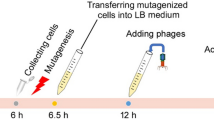Abstract
The inclusion of drug-resistance plasmids (R-plasmids) in Escherichia coli strains has been shown to determine the formation of specific surface structures which could modify bacterial surface characteristics relevant for pathogenic processes.
Thirtyone R-plasmids (from different incompatibility groups) have been transferred to three E. coli laboratory strains, and surface hydrophobicity modifications have been measured by three methods: “salting-out”, adsorption to hexadecane and adsorption to xylene.
The results obtained show that the presence of R-plasmids produced variations which are dependent on the receptor strains and measuring method employed. Also, it has been found that the plasmids behave differently depending on the strain in which they are included.
The results obtained by the “salting-out” method are not correlative with those obtained by adsorption to hydrocarbons, probably due to the implication of different hydrophobic molecules in the interaction with salt or hydrocarbons.
Concluding, the choice of receptor strain and measuring method are of great importance for the investigation of surface hydrophobicity (and probably other characteristics) encoded by R-plasmids.
Similar content being viewed by others
Abbreviations
- TSB:
-
Trypticase soya broth
- TSA:
-
trypticase soya agar
References
Bradley DE (1980) Determination of pili conjugative bacterial drug resistance plasmids of incompatibility groups B, C, H, J, K, M, V and X. J. Bacteriol. 147:828–837
Ferreirós CM, Criado MT (1983) Different expression and genetic control for the K99 antigen and its associated adhesin. Curr Microbiol 8:221–225
Gibbons JD (1976) Interences concerning location based on two or more samples. In: Massey H (ed) Non-parametric methods for quantitative analysis. Holt, Rinehart and Winston, New York, pp 157–204
Lindahl M, Faris A, Wadstrom T, Hjerten S (1981) A new test based on “salting-out” to measure relative surface hydrophobicity of bacterial cells. Biochim Biophys Acta 677:471–476
Nesbitt WE, Doyle RJ, Taylor KG (1982) Hydrophobic interactions and the adherence of Streptococcus sanguis to hydroxylapatite. Infec Immun 38:637–644
Rosenberg M, Gutnick D, Rosenberg E (1980) Adherence of bacteria to hydrocarbons: a simple method for measuring cell-surface hydrophobicity. FEMS Microbiol Lett 9:29–33
Rosenberg M, Rotterm S, Rosenberg E (1982) Cell surface hydrophobicity of smooth and rough Proteus mirabilis strains as determined by adherence to hydrocarbons. FEMS Microbiol Lett 13:167–169
Vosbeck K, Mett H (1984) Bacterial adhesion: Influence of drugs. Med Microbiol 3 (in press)
Weiss E, Rosenberg M, Judes H, Rosenberg E (1982) Cell-surface hydrophobicity of adherent oral bacteria. Curr Microbiol 7:125–128
Author information
Authors and Affiliations
Rights and permissions
About this article
Cite this article
Ferreirós, C.M., Criado, M.T. Expression of surface hydrophobicity encoded by R-plasmids in Escherichia coli laboratory strains. Arch. Microbiol. 138, 191–194 (1984). https://doi.org/10.1007/BF00402118
Received:
Accepted:
Issue Date:
DOI: https://doi.org/10.1007/BF00402118




